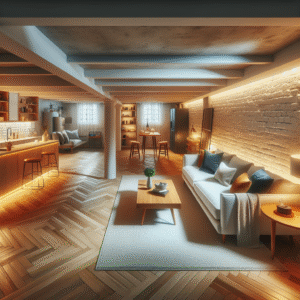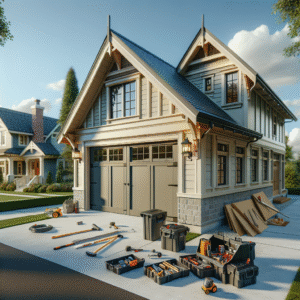Choosing the right roofing material is one of the most critical decisions for your home. The roof is a key element that protects your home from the elements and enhances its overall aesthetic appeal. With various roofing materials available, it’s essential to understand the advantages and disadvantages of each option before making a decision. In this guide, we’ll explore the pros and cons of different roofing materials to help you choose the best option for your home.
1. Asphalt Shingles
Pros:
- Affordability: Asphalt shingles are one of the most cost-effective roofing materials available, making them a popular choice for homeowners on a budget.
- Ease of Installation: These shingles are relatively easy and quick to install, which can help reduce labor costs.
- Variety of Styles: Available in a wide range of colors and styles, asphalt shingles can complement virtually any home design.
- Durability: Asphalt shingles can last 15-30 years, depending on the quality of the material and the weather conditions in your area.
Cons:
- Shorter Lifespan: While asphalt shingles are durable, they don’t last as long as other roofing materials such as metal or slate.
- Susceptible to Weather Damage: Asphalt shingles can be damaged by extreme weather conditions, such as heavy winds, hail, and intense sunlight.
- Not Environmentally Friendly: Asphalt shingles are made from petroleum products and are not as eco-friendly as other roofing options.
2. Metal Roofing
Pros:
- Longevity: Metal roofs can last 40-70 years or more, making them one of the most long-lasting roofing materials.
- Durability: Metal is highly resistant to harsh weather conditions, including strong winds, heavy rain, and snow. It’s also fire-resistant.
- Energy Efficiency: Metal roofs reflect sunlight, which helps to keep your home cooler in warm weather and can reduce energy costs.
- Low Maintenance: Metal roofing requires minimal maintenance compared to other materials.
Cons:
- Higher Initial Cost: The upfront cost of metal roofing is higher than asphalt shingles, though the long lifespan helps offset the initial investment.
- Noise: Metal roofs can be noisier during rainstorms, though this can be mitigated with proper insulation.
- Expansion and Contraction: Metal expands and contracts with temperature changes, which may cause issues if not installed properly.
3. Slate Roofing
Pros:
- Extremely Long Lifespan: Slate roofing is one of the most durable materials, with a lifespan of over 100 years if properly maintained.
- Aesthetic Appeal: Slate offers a unique, natural appearance that adds elegance and value to any home.
- Fire and Weather Resistant: Slate is highly resistant to fire, extreme temperatures, and severe weather conditions.
- Eco-Friendly: Since slate is a natural material, it has a lower environmental impact compared to synthetic roofing options.
Cons:
- Expensive: Slate is one of the most expensive roofing materials, both in terms of material cost and installation.
- Heavy Weight: Slate is a very heavy material, so your home may require additional structural support to accommodate the weight.
- Complex Installation: Installing slate requires specialized skills, which can increase labor costs.
4. Wood Shingles and Shakes
Pros:
- Natural Aesthetic: Wood shingles and shakes offer a rustic, natural look that enhances the charm of many homes, particularly in more traditional or rural settings.
- Insulation Properties: Wood provides natural insulation, helping to keep your home warmer in the winter and cooler in the summer.
- Eco-Friendly: If sourced sustainably, wood shingles are an environmentally friendly option as they are biodegradable and renewable.
Cons:
- High Maintenance: Wood roofing requires regular maintenance to prevent mold, mildew, and insect damage.
- Flammability: Unless treated, wood shingles are not fire-resistant, which can be a concern in areas prone to wildfires.
- Shorter Lifespan: Wood roofs typically last 20-30 years, but they may require frequent repairs due to weather-related damage.
5. Clay and Concrete Tiles
Pros:
- Durability: Clay and concrete tiles are highly durable and can last 50-100 years or more with proper care.
- Fire Resistant: These materials are non-combustible, providing excellent fire protection.
- Energy Efficient: Clay and concrete tiles offer good insulation properties, helping to regulate indoor temperatures.
- Aesthetic Variety: Available in a wide range of colors and styles, clay and concrete tiles can suit various architectural styles, from Mediterranean to modern.
Cons:
- Heavy: Like slate, clay and concrete tiles are heavy and may require additional structural support for your home.
- Expensive: Both materials are more expensive than asphalt shingles, both in material and installation costs.
- Fragile: While durable, clay and concrete tiles can crack or break if struck by heavy objects, such as falling branches.
FAQ
1. Which roofing material is the most cost-effective?
Asphalt shingles are generally the most cost-effective option, offering affordability and ease of installation. However, they have a shorter lifespan compared to other materials like metal or slate.
2. What is the longest-lasting roofing material?
Slate roofing has the longest lifespan, often lasting over 100 years. Metal roofing is another long-lasting option, with a lifespan of 40-70 years.
3. Are metal roofs energy-efficient?
Yes, metal roofs are highly energy-efficient. They reflect sunlight, which helps keep your home cooler and can lower energy costs during hot weather.
4. Do I need additional structural support for heavy roofing materials?
Yes, heavy materials such as slate, clay, and concrete tiles may require extra structural support to handle their weight. It’s important to consult with a professional before installing these materials.
5. What is the most environmentally friendly roofing material?
Slate and metal are considered eco-friendly options. Slate is a natural material with a long lifespan, and metal can be recycled. Wood shingles can also be eco-friendly if sourced from sustainable forests.
Conclusion
Choosing the right roofing material for your home depends on various factors, including your budget, the climate in your area, and the desired aesthetic. Each roofing material has its own set of pros and cons, so it’s important to weigh these considerations before making a decision. Whether you prioritize cost, durability, or appearance, understanding the strengths and weaknesses of different roofing materials will help you select the best option for your home.








